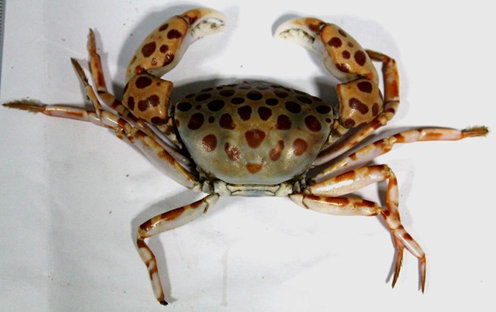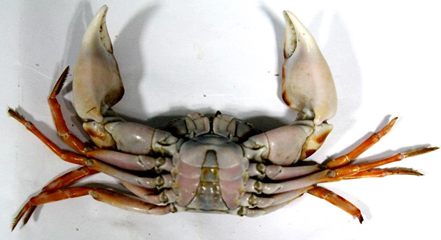Research Article
Volume 2 Issue 6 - 2018
Liagore rubromaculata (De Hann, 1835), a new record of xanthid crab (Family Carpiliidae) Ortmann, 1893 (Crustacea: Decapoda: Xanthidae), off Tuticorin Coast, India
Tilapia Project- Hatchery Technical and Head, Victoria Treasures Limited, BUGABO BAY GARUGA on Victoria Lake, Kampala, Uganda, East Africa
*Corresponding Author: T Vaitheeswaran, Tilapia Project- Hatchery Technical and Head, Victoria Treasures Limited, BUGABO BAY GARUGA on Victoria Lake, Kampala, Uganda, East Africa.
Received: December 06, 2017; Published: June 15, 2018
Abstract
Liagore rubromaculata (De Hann, 1835) the first occurrence this species of the genus Liagore, theincidental by-catch specimen, off Tuticorin coastal waters. By-catch specimen between 08º 53.6’N 78º 16’E and 08º 53.8’N 78º 32’E, water surface below the depth ranges from 305- 310 m. Further study is being essential to be assessing the resource management and assessment of biodiversity of xanthid crab, off Tuticorin coast of India.
Keywords: Liagore rubromaculata; New record; Xanthidae; Carpiliidae; Tuticorin coast
Introduction
The genus Liagore De Hann, 1833 have been the most value and bright colorful members of the Xanthidae. The group of members has been the three species viz, Liagore rubromaculata(De Hann, 1835), L. erythematica(Guinot, 1971) and L. pulchella (Ng and Naruse, 2007) from the Indo-Pacific region. Liagore rubromaculata the brightly red in colour spots and dots all over the carapace and perioopods. During the periodical assessment of by-catch all marine invertebrates, especially in crustacean xanthid group of specimen, off Tuticorin, the large trawler catchment area of xanthid that was clearly indicate a species of genus Liagore with red dot and spots. Only one species, Liagore rubromaculata (De Hann, 1835) have been recorded from Tuticorin coast, now newly rare occurrence of Tuticorin coast of India.
Class Crustacea
Order Decapoda
Family Carpiliidae Ortmann, 1893,
Genus Liagore De Hann (1833)
Species rubromaculatus De Hann (1835)
Cancer (Liagore rubromaculata)
Liagore rubromaculata Alcock, 1898, 67 (2): 67-233
Kemp, 1923; 25 (4): 405-409
Chopra, 1935; 37(4): 463-514
Campbell and Stephenson, 1970; 15(4):235-302, figs 1-49, pl. 22 1
Guinot, 1971; 2, 42(5): 1091-1098
Sakai, 1976; 389, pl. 136, fig 1
Krishnamoorthy, 2009; 304: 24
Class Crustacea
Order Decapoda
Family Carpiliidae Ortmann, 1893,
Genus Liagore De Hann (1833)
Species rubromaculatus De Hann (1835)
Cancer (Liagore rubromaculata)
Liagore rubromaculata Alcock, 1898, 67 (2): 67-233
Kemp, 1923; 25 (4): 405-409
Chopra, 1935; 37(4): 463-514
Campbell and Stephenson, 1970; 15(4):235-302, figs 1-49, pl. 22 1
Guinot, 1971; 2, 42(5): 1091-1098
Sakai, 1976; 389, pl. 136, fig 1
Krishnamoorthy, 2009; 304: 24
Type Locality
The carapace length of the male 5.3 cm, breadth 6.9 cm, off Tuticorin coast of India, Gulf of Mannar, between 08º 53.6’N 78º 16’E and 08º 53.8’N 78º 32’E, depth range from 305 to 310 m.
The carapace length of the male 5.3 cm, breadth 6.9 cm, off Tuticorin coast of India, Gulf of Mannar, between 08º 53.6’N 78º 16’E and 08º 53.8’N 78º 32’E, depth range from 305 to 310 m.
Distribution
Queensland Central East Coast, Northeast coast, Hong Kong, Republic of Singapore and Japan; Extra-limital distribution- east Indo-west Pacific Oceans; Sandheads at Mouth of River Hugli, Royapuram Fish landing region, Chennai (Krishnamoorthy, P. 2009) and Tuticorin coast and it extend to southeast coast of India.
Queensland Central East Coast, Northeast coast, Hong Kong, Republic of Singapore and Japan; Extra-limital distribution- east Indo-west Pacific Oceans; Sandheads at Mouth of River Hugli, Royapuram Fish landing region, Chennai (Krishnamoorthy, P. 2009) and Tuticorin coast and it extend to southeast coast of India.
Colour
The presence of distinctive brick-red spots on the dorsal surfaces of the carapace and pereiopods.
The presence of distinctive brick-red spots on the dorsal surfaces of the carapace and pereiopods.
Diagnosis
Carapace transversely oval, smooth, convex and punctulate; on its surface symmetrically disposed red blots; regions ill defined, only a distinct H-shaped depression located between gastric and cardiac regions. Antero-lateral margin smooth and unarmed. Posterior margin slightly concave. Front broad, divided into 2 lobes, anterior margin of lobe slightly concave near the outer-distal angle. Orbit small, eye-peduncle stout and short. Chelipeds smooth, symmetrical. Merus with several obtuse teeth on dorsal margin. Carpus with inner- and outer-distal angle blunt and produced. Palmsubequal to finger in length. Fingers bearing irregular obtuse teeth on the inner margins. Ambulatory legs elongate, thin and cylindrical; surface smooth and glossy, first leg the longest, the second to fourth pairs gradually decreasing in length; dactyli sharp, provided with short hairs. First pleopod of the male elongate and slender, distal part armed with long hairs on the inner side, and acute granules on the outer side. Male abdomen triangular; third to fifth segments fused, but suture still recognizable; the terminal segment with distal margin bluntly round. Female abdomen oblong.
Carapace transversely oval, smooth, convex and punctulate; on its surface symmetrically disposed red blots; regions ill defined, only a distinct H-shaped depression located between gastric and cardiac regions. Antero-lateral margin smooth and unarmed. Posterior margin slightly concave. Front broad, divided into 2 lobes, anterior margin of lobe slightly concave near the outer-distal angle. Orbit small, eye-peduncle stout and short. Chelipeds smooth, symmetrical. Merus with several obtuse teeth on dorsal margin. Carpus with inner- and outer-distal angle blunt and produced. Palmsubequal to finger in length. Fingers bearing irregular obtuse teeth on the inner margins. Ambulatory legs elongate, thin and cylindrical; surface smooth and glossy, first leg the longest, the second to fourth pairs gradually decreasing in length; dactyli sharp, provided with short hairs. First pleopod of the male elongate and slender, distal part armed with long hairs on the inner side, and acute granules on the outer side. Male abdomen triangular; third to fifth segments fused, but suture still recognizable; the terminal segment with distal margin bluntly round. Female abdomen oblong.
Remarks
Liagore rubromaculata has been reported as earlier by Kemp (1923) were collected by ‘Lady Fraser’ at Sand heads and in addition that Guinot (1971) has been reviewed and recorded at Kolkata (Calcutta) a new species L. erythematica it seems to new from West Bengal (East coast of India). Ng and Naruse (2007) has been reported L. pulchella as third extent species and L. rubromaculata from Vanuatu, among only as a fossil species. Now L. rubromaculata have been reported for the first time in Tuticorin coast, India at a depth upto 310 m.
Liagore rubromaculata has been reported as earlier by Kemp (1923) were collected by ‘Lady Fraser’ at Sand heads and in addition that Guinot (1971) has been reviewed and recorded at Kolkata (Calcutta) a new species L. erythematica it seems to new from West Bengal (East coast of India). Ng and Naruse (2007) has been reported L. pulchella as third extent species and L. rubromaculata from Vanuatu, among only as a fossil species. Now L. rubromaculata have been reported for the first time in Tuticorin coast, India at a depth upto 310 m.
References
- Alcock A. “Materials for a carcinological fauna of India No.3. Brachyura Cyclometopa, Part-I. The family Xanthidae”. The journal of the Asiatic Society of Bengal 67.2 (1898): 67-233.
- Campbell BM and Stephenson W. “The Sublittoral Brachyura (Crustacea: Decapoda) of Moreton Bay”. Brisbane:Queensland Museum 15.4 (1970): 235-302.
- Chopra B. “Notes on Crustacea Decapoda in the Indian Museum. VIII. on the Decapod Crustacea collected by the Bengal Pilot Service off the mouth of the River Hugli. Brachygnatha (Oxyrhyncha and Brachyrhyncha)”. Records of the Indian Museum 37.4 (1935): 463-514.
- Haan HM De. “1833–1849. Crustacea. In: P. F. von Siebold, Fauna Japonica, sive Descriptio animalium, quae in itinere per Japoniam, jussu et auspiciis superiorum, qui summum in India Batavia imperium tenent, suscepto, annis1823–1830 collegit, notis, observationibusa adumbrationibus illustravit. Lugduni Batavorum, fasc”.
- Guinot D. “Sur l existence d une deuxieme expece de Liagore De Haan, L. erythematic asp”. Nov. Bull. Mus. Natn. Hist. nat. Paris (Ser. 2) 42.5 (1971): 1091-1098.
- Krishnamoorthy P. “Brachyuran crabs from the collections of Marine Biological Centre”. Rec. zool. Surv. India, Occ. Paper No 304 (2009): 1-46.
- Kemp S. “Notes on Crustacea Decapoda in the Indian Museum. XVI. On two interesting crabs from the mouth of the river Hughli”. Records of the Indian Museum 25.4 (1923): 405-409.
- Ng PKL and Naruse T. “Liagore pulchella, a new species of xanthid crab (Crustacea: Decapoda: Brachyura) from Vannatu”. Zootaxa 1665 (2007): 53-60.
- Ortmann A. “Die Decapoden–Krebse des Strassburger Museums. VII. Theil. Abtheilung: Brachyura (Brachyura genuina Boas) II. Unterabtheilung: Cancroidea, 2. Section: Cancrinea, 1.Gruppe: Cyclometopa, Zoologische Jahrbücher, Abtheilung für Systematik, Geographie und Biologie der Thiere”. 7 (1893): 411-495.
- Davie, P. (2009). Liagore rubromaculata (De Haan, 1835). Accessed through: World Register of Marine Species at http://www.marinespecies.org/aphia.php?p=taxdetails&id=444286 on 2017-12-04
- Huang, 1994 Liagore rubromaculata L. pulchella can be distinguished from L. rubromaculata (De Haan, 1835), and L. erythematica Guinot, 1971
Citation:
T Vaitheeswaran. “Liagore rubromaculata (De Hann, 1835), a new record of xanthid crab (Family Carpiliidae) Ortmann, 1893
(Crustacea: Decapoda: Xanthidae), off Tuticorin Coast, India”. Innovative Techniques in Agriculture 2.6 (2018): 514-517.
Copyright: © 2018 T Vaitheeswaran. This is an open-access article distributed under the terms of the Creative Commons Attribution License, which permits unrestricted use, distribution, and reproduction in any medium, provided the original author and source are credited.































 Scientia Ricerca is licensed and content of this site is available under a Creative Commons Attribution 4.0 International License.
Scientia Ricerca is licensed and content of this site is available under a Creative Commons Attribution 4.0 International License.